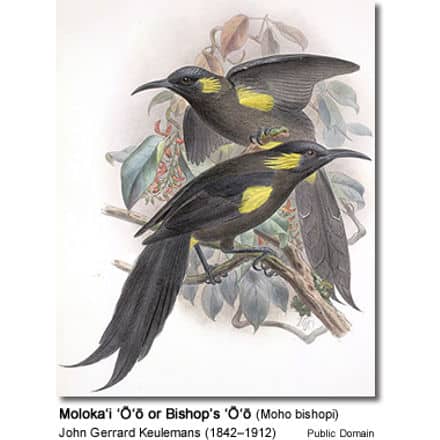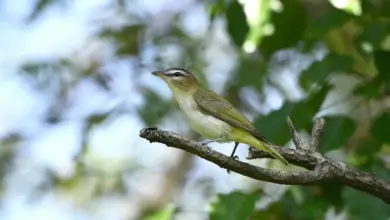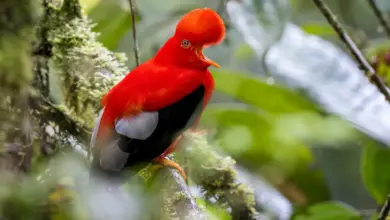Molokai O’o or Bishop’s O’o (Moho bishopi)
The Molokai O’o or Bishop’s O’o (Moho bishopi) is a member of the extinct genus of the Oo’s (Moho) within the extinct family Mohoidae.
It was previously regarded as member of the Australo-Pacific honeyeaters (Meliphagidae). Lionel Walter Rothschild named it after Charles Reed Bishop, the founder of the Bishop
Description
It was discovered in 1892 by Henry C. Palmer, a bird collector for Lord Rothschild. Its length was about 29 centimetres. The tail had reached a length of 10 centimetres. The plumage was general glossy black with yellow feather tufts on the maxillaries (upper bill), beneath the wings and the undertail coverts. Their songs were simple two notes, took-took, Which could be heard for miles.
Distribution
It was endemic to the montane forests in the eastern of the Hawaiian Island of Molokai, and Mount Olokai. Subfossil bone finds are known from Maui, on Mount Olinda at about 4,500 above sea level.
Ecology
Little is known about its ecology. It fed and on nectar from the flowers of Hawaiian lobelioids.
Extinction
Causes of the bird’s extinction include deforestation, competition from introduced predators, hunting by local tribes due to the much sought yellow feathers to create the precious capes for the nobility, and diseases which were introduced by mosquitoes.
It was last seen in 1904 by ornithologist George Campbell Munro. In 1915 Munro tried to verify reports of eventual sightings but he never found this bird again. In 1981 there was an allegedly rediscovery on Maui although this sighting was never confirmed.
Specimens
Today the bird can only be seen as specimens, paintings, picture notes, and skins. So far there are recorded in Bremen, Cambridge, Mass;. Honolulu; London; Molokai, Hawaiian Islands; New York; and Stockholm.
References
- Fleischer R.C., James H.F., and Olson S.L. (2008). Convergent Evolution of Hawaiian and Australo-Pacific Honeyeaters from Distant Songbird Ancestors. Current Biology, Volume 18, Issue 24, 1927-1931, 11 December 2008.
- Munro, George C. (1944 and its revised 2nd. edition from 1960): Birds of Hawaii
- Flannery, Tim and Schouten, Peter (2001): A Gap in Nature
- Fuller, Errol (2000): Extinct Birds
- Day, David (1981): The Doomsday Book of Animals
- Greenway, James C. (1967): Extinct and Vanishing Birds of the World
- Luther, Dieter (2005): Die ausgestorbenen Vögel der Welt
External links
- Fact Sheets Bishops Oo






